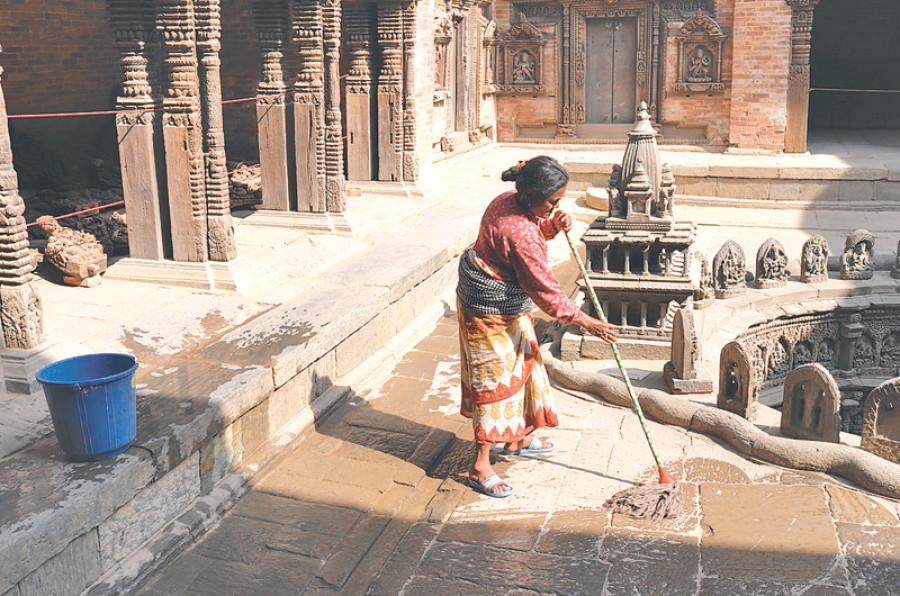Entertainment
A Labour of Love
During the April 25 earthquake, Santa Bahadur Tamang was all alone in his rented room near Patan Durbar Square; he did not know where the other members of his family were.
Sophia L Pandé
During the April 25 earthquake, Santa Bahadur Tamang was all alone in his rented room near Patan Durbar Square; he did not know where the other members of his family were. When he rushed out, there were terrifying swirls of dust flying everywhere, along with collapsed buildings, temples, and people who had been stripped of their wits by the magnitude of the shake. It was a Saturday, close to noon, and Menuka Maharjan was also at home; with two children, one of whom is a seventeen-year-old student, she thanks god that the children were not in school buildings due to the weekly holiday as thousands of classrooms collapsed in rural areas.
Santa Bahadur and Menuka live and work in Patan, doing the manual jobs or jyami kaam that is necessary and integral to heritage conservation. Having worked at the Kathmandu Valley Preservation Trust (KVPT), a 25 year old organisation based in Patan that both restores and preserves centuries old Newah heritage sites, for 13 and seven years respectively, Santa Bahadur and Menuka, in addition to being Patan residents (Santa Bahadur was born in Bhaktapur and Menuka is originally from Ramechhap), had another, deeper, stake in the culture that surrounds them—they have contributed to help re-build and maintain a considerable amount of it with their own hands. When these magnificent edifices that had taken so much of their sweat (and those of many, many others) went up in dust, they felt a very deep sense of distress. It was a loss for the aesthetes but perhaps more importantly, also the potential loss of a living culture.
Post-earthquake Patan was unique in being able to sort and salvage significant parts of the temples and monuments that had collapsed—due to the strength of the community and the watchful eye of Rohit Ranjitkar and his team at KVPT who, along with the local volunteers, and police, and people like Menuka and Santa Bahadur, were able to find and put away safely much of what was destroyed. Broken idols, cracked struts, old bricks, everything that could be re-used or put back together was taken from the rubble and ferried by these dedicated individuals. When the second earthquake hit, the two workers were in the Mul Chowk of the Patan Durbar Square, they had been fixing things onto the roof and had just come down when the earth started to shake again. Objects fell off the roof, people were petrified, but Santa Bahadur got back up onto the higher parts of the edifice perched on a ladder, held by a single person at the bottom, to help cover the gaping holes in the roof with tarpaulins to prevent it from water damage. He was scared, but duty called.
Almost two years on, Menuka and Santa Bahadur smile as they describe their contentment at seeing both the Mul Chowk and the Sundari Chowk looking so beautiful. They worked on both of these sites, carefully exposing the old brick tiles and looking for the original joins and foundations.

They can remember the desperate state of the pond and the well in the Bhandarkhal Garden just behind the palace complex. The disrepair is now barely imaginable, but a few years ago, jyamis like Menuka had to pull out, by hand, unruly plant growth like stinging nettle that had pervaded all the surfaces. Today, anyone, including these two, can sit by the pond and eat their 2 pm khaja in the beautiful, peaceful green open area that surrounds the now pristine-looking pond.
Sometimes, their limbs ache, but they do not want to stay home, they say, because then the pains get even worse. They are grateful to be able to work for a living, and even more so that there is meaningful work for them at an organisation that they know and trust.
So much collapsed during the earthquake, but Patan is a story of hope, with the two newly-restored chowks and their now-accessible light-filled, upper galleries symbolising the infinite amount of labour and care that went into their restoration.
At the time that this interview was taken, Santa Bahadur and Menuka were digging to find the original foundations of the Vishwanath Temple. They have been at it for two weeks, four men and four women, excavating through metres of packed earth trying to find the centuries old brick. It is the hardest kind of work, they say, but they know how to do it after all these years, and they teach their fellows how to do it correctly.
Arriving at 9.45 am to start work at 10.00 am sharp requires full bellies they say, and so they have woken up at dawn, cooked, cleaned, done the laundry, sent their children off to school, eaten their bhaat and arrived promptly to start their day of what can only be described as back-breaking work. Santa Bahadur wears white cloth gloves the day I meet him, to protect his hands, and Menuka a dust mask that she never takes off throughout the interview. Without them, the stone, brick, and wood that goes into the rebuilding would never get from Point A to Point B. Without people like them, working hard conscientiously, day after day, our temples would never be rebuilt.




 9.12°C Kathmandu
9.12°C Kathmandu











